
Early mixed analog-digital application <br> <br> traditional analog surveillance system, for example, analog control technology with a complete proven solutions, technology is mature, stable system that has been occupying an important market share in the domestic and international surveillance fundamental, However, it is limited by its inherent technical limitations in video clarity, video transmission distance, control deployment, and business applications, affecting its application scope and subsequent development. In order to solve video resource integration first, and more convenient and effective unified management of video resources, analog surveillance systems mostly convert analog signals to digital ones to achieve the purpose of unifying video resources. This is also an early application of mixed-signal applications. As shown.

This early general-purpose analog-digital mixing structure, the analog video signal is connected to the matrix via a coaxial cable, and then the video signal is output to the large-screen display area through the matrix to achieve the effect of real-time monitoring. At the same time, the video is distributed to the digital at the front end. DVRs are locally encoded and stored. This architecture uses the matrix as a central control to enable front-end access to video switching output, but the storage and retrieval of analog video signals relies on embedded DVRs or encoders to convert analog video signals to specific digital codes. Rule-encoded digital video signals that enable the local storage of video resources and the sharing of video to video private networks. In order to realize the effective scheduling and management of video resources, the unified network on-line management of the embedded digital video recorder DVR is utilized, and the demand for unified resource scheduling is well achieved.
This analog-digital hybrid architecture mixed analog-digital application development <br> <br> described earlier it is since the embedded digital hard disk video recorder and encoder popularity of the most common architecture, realized investment protection original analog control system, as well as It also provides solutions for the unified management of video resources. However, the products that make up this kind of system are becoming more and more popular in high-definition and high-definition intelligentization. At the present stage, the performance and functions such as definition and video analysis have obviously not adapted to the rapid development of video surveillance systems. .
As shown in the figure below, Channel 9, Channel 11, and Channel 12 are analog SD effects, while Channel 10 is a coaxial HD image effect. The effect of analog SD is only to see the approximate scene. See if there is anyone, see To the direction of people, and the effect of upgrading after HD upgrade is obvious, can see more details, such as scenes of vehicle information, character characteristics information and so on.
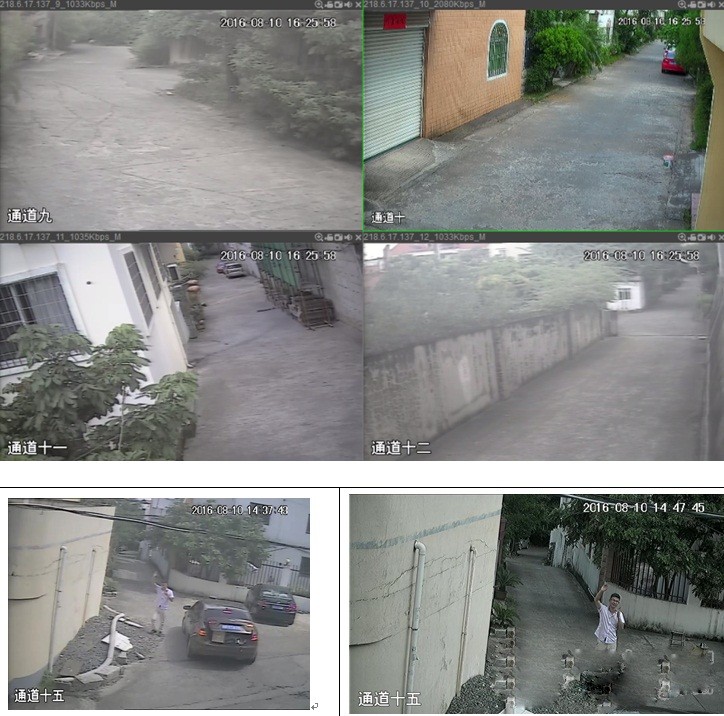
In order to seamlessly interface with the original analog surveillance system, smoothly upgrade to high-definition, and inherit the advantages of the original analog surveillance system in real-time, safe, stable and reliable, the industry has been continuously introducing new application technologies, such as Sony's 960H analog high-definition For example, HDSDI technology was introduced into the field of security video surveillance.
The effect of the 960H analog HD has been proven to be unable to meet the demand for true high-definition, and the advent of the HDSDI is for the industry to shine. HDSDI uses high-quality coaxial cable to transmit digital video signals and provides up to 720P/1080P video images. Its architecture deployment and manipulation habits are similar to those of analog SDTV systems, and can be easily integrated with dedicated SDI optical transceivers and SDI digital hard disk recorders. To the original video surveillance system, it inherits the characteristics of real-time, security and other features of the analog surveillance system. This hybrid high-definition architecture has already broken through the traditional sense of "modulus" mixing. However, in my opinion, HDSDI technology does not fully realize the replacement of analog systems. The limitations of HDSDI front-end transmission distance, construction finesse, and high cost of production have limited the popularity of HDSDI in the market and it is difficult to realize the modulus. An effective upgrade of the simulation part of the hybrid system.
In this case, the high-definition development of the analog-digital hybrid system has always been based on high-definition network, while the analog monitoring system based on coaxial cable has been unable to solve the coverage and inheritance of the original system.
Coaxial HD technology is a dark horse that has emerged for two years and has become one of the most popular basic technologies in the global security market in the past two years. Coaxial high-definition technology supports 720P/1080P and even higher 4 million and 4K image resolutions. It also supports coaxial control signals and audio signals composited on the video signals, and ensures that the high-definition video signals are super-distant on the coaxial cable. Transmission, this technology effectively solved the inheritance of the characteristics of the original analog SD system, and effectively realized the need for high-definition analog system architecture. It was quickly sought after in the global market after its launch. A new model based on coaxial high-definition technology was adopted. Hybrid applications have also grown rapidly.
New Developments in HD Analog Mixed Applications
At the end of 2014, the “Safety Defense HD Video Surveillance System Technical Requirements GA/T1211-2014†was formally approved by the National Security and Alarm Systems Standard Committee. The standard was officially implemented in April 2015. The standard proposes that "HD video surveillance system is mainly composed of three parts: front-end, transmission, and terminal. According to its different transmission methods, it can be divided into three types: IP network type, non-IP network type, and hybrid type."
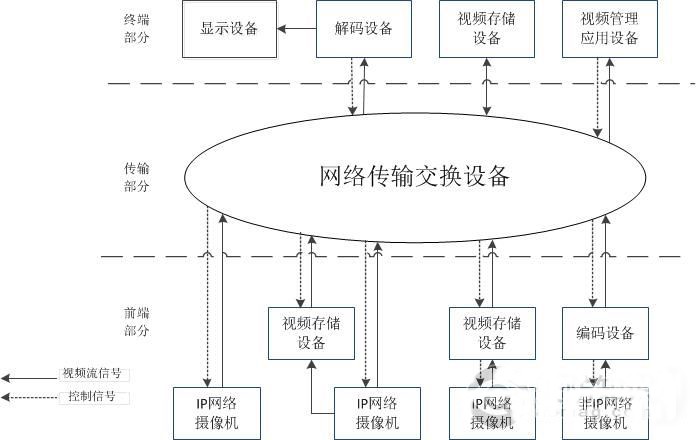
Among them, the IP network high-definition video surveillance system refers to the video signal transmission system through the IP network, its logical structure as shown below; non-IP network high-definition video surveillance system refers to the video signal transmission in addition to other than the IP network The system's logical architecture is shown in the figure below:
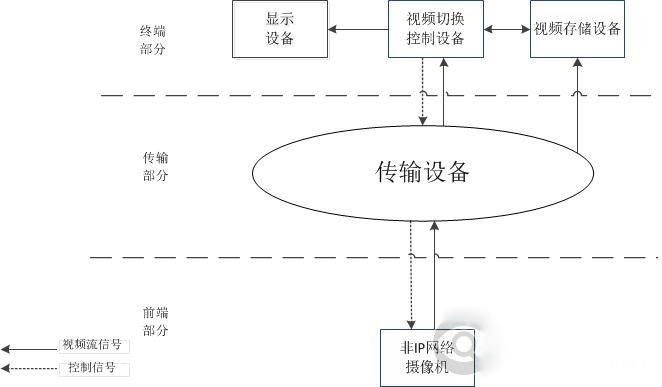
The high-definition video surveillance systems of these two kinds of architectures once blew up in the market with only IP network HD and HDSDI HD, especially IP network HD. The system relied on mature network transmission methods and accounted for most of the newly-built HD systems. Non-IP network-based high-definition video surveillance is limited by cost, technology implementation, and other reasons, and it also has a considerable market share in some special areas.
In the "Security Protection High-Definition Video Surveillance System Technical Requirements GA/T1211-2014" standard, a third high-definition video surveillance system was specifically introduced, namely, a hybrid high-definition video surveillance system. The standard mentioned that the hybrid high-definition video surveillance system is a combined application of IP network and non-IP network systems; according to the actual demand, the hybrid HD video surveillance system can have multiple combination modes. The main architecture is shown in the following figure:

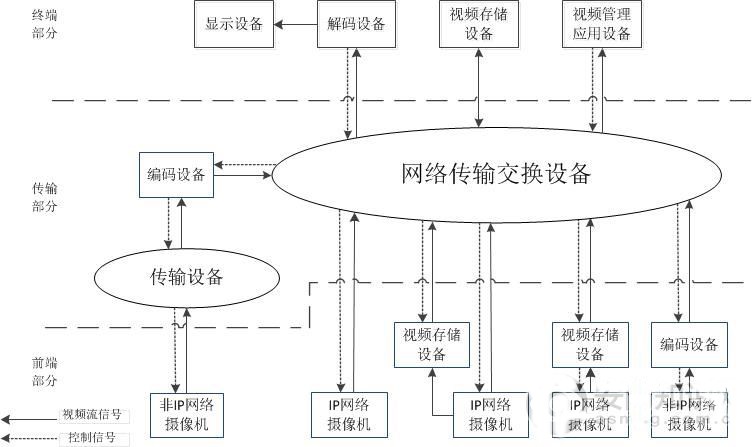
From the topology, it can be seen that the hybrid high-definition video surveillance system has changed the situation in the past with only a single architecture. The designer or customer can use the current mainstream HD technology to achieve high-definition video according to their actual project needs. The architecture of the monitoring system, which is closer to the actual pain points of customers.
In the construction of some safety precautions in China, the video surveillance system is a must-build subsystem in many industries. Due to the phased construction of the system and the different construction periods, there is a phase 1 analog standard definition, phase 2 SDI HD, and phase 3 network HD. In the case of modulo mixing, it can be said that it is still very common in various industries. Take * as an example, the early days eye projects are mainly based on analog SD, followed by new-level ones mostly with high-definition. The upgrading of standard-standard resources within the project is a difficult point; take the domestic subway track construction as an example. North, Shanghai, Guangzhou, and Shenzhen are at the forefront of track construction. However, the video surveillance system is still an early analog-standard SD system. Although the integration of system resources has been completed, the inconvenience of definition still limits the follow-up services in these projects. Development, how to achieve high-definition upgrade is also a pain point placed in front of users. What kind of high-definition access method is selected can ensure both the new HD effect and the smooth HD upgrade of the previous system, which is currently the most concern for users in various industries.
In the GA/T1211-2014 standard, the hybrid high-definition video surveillance system section gives a reference to the basic technology:
6.1.1 The system equipment shall comply with the requirements of the current national standards and meet the environmental adaptability and electromagnetic compatibility requirements of the use site.
6.1.2 The performance and technical requirements of various ancillary equipment of the system shall be coordinated to ensure that the image quality of the high-definition video surveillance system meets the system performance indicators.
6.1.3 The video codec equipment involved in the system should use video coding and decoding standards such as SVAC, H.264, and H.265. The SVAC video coding standard should be given priority.
6.1.4 The equipment involved in the information exchange, transmission and control of the IP network in the system shall meet the GB/T28181 standard.
6.1.5 Devices in the system that involve non-IP networks should support HD-SDI, HD-CVI, and other interfaces that comply with IEC 62676-3, HDcctv2.0S1200, or HDcctv2.0S1205.
In the hybrid high-definition video surveillance system, the standard has given the recommended access method or interface technology, and HDCVI coaxial high-definition technology in it can be effective in this hybrid high-definition system with the HDCVI coaxial high-definition technology. Coverage and inheritance of the original analog SD system, has a strong technical advantage in the construction of hybrid high-definition video surveillance systems.
Remarks:
High Definition Video Surveillance System
System video resolution is greater than or equal to 1920×1080, the system video resolution is greater than or equal to 800TVL.
Note: The system image resolution is greater than or equal to 1280 × 720 and less than 1920 × 1080, the horizontal resolution of the system image is greater than or equal to 600TVL, called the quasi-high-definition video surveillance system.
HDCVI: High definition composite video interface (High definition composite video interface)
HD-SDI High Definition Serial Digital Interface (HighDefinitionSerialDigitalInterface)
SVAC Security Surveillance Digital Video and Audio Coding (SurveillanceVideoandAudioCoding)
Looking to continuous improvement and continuous development of technology <br> <br> socio-economic objective of the video surveillance system accuracy, validity, reliability, convenience and a higher requirement.
Specifically speaking, one of them is that the degree of industrialization and professional application will continue to deepen. Traditional security monitoring will surely develop the monitoring and control of the nature required by the industry, and also cover the coverage and implementation distance of the same system. The higher requirements, multifaceted coverage, and professional appeals of different industries will be the key to the entire HD video surveillance system construction program, and more and more requirements will be placed on the basic technical capabilities.
The second is the integration and utilization of video resources and professional business resources, realizing the centralized optimization of big data, achieving the effect of building and using, and turning video resources into value resources.
These two requirements are consistent with the demand for video resource integration applications and high-definition video surveillance. High-definition and resource integration have become the basic requirements for meeting system requirements. According to the actual application of customers, we now have more choices of high-definition technology to meet the different construction needs of customers. These will be the places for hybrid solutions and the high-definition hybrid video surveillance system will also be in the future. The industry has been upgraded to a new level.
The rack roll forming machine includes one decoiler, servo feeder, hydraulic punching, roll forming and hydraulic cutting. The products of the rack roll forming machine are used as racks and shelves for supporting the daily commodities in supermarkets and shops.
1.Fast speed
2.Elegant appearance
3.PLC control, full automatic
4.Manufacture as buyer's requirements
Specifications:
Raw material
Colored steel, Galvanized steel
Material thickness range
1.5-3.0mm
Rollers
18-24 rowa(according to drawings and size)
Material of rollers
45# steel with chromed
Shaft diameter and material
80mm, material is 40Cr
Material of cutting blade
Cr12 mould steel with quenched treatment
Forming speed
6-8m/min(include the punching)
Way of driven
Chain transmission or Gear box
Controlling system
Siemens PLC
Main motor power
15KW
Hydraulic station power
11KW
Voltage
380V/3Phase/50Hz or at buyer's request
Size of the machine
L*W*H 12m*2.0m*1.6m
Working process:

Decoiler - Seven rollers leveling - Servo feeding - Power press - Material guiding - Main roll forming machine
- PLC control system - Hydraulic cutting (45°) - Receiving table
Pictures for machine:
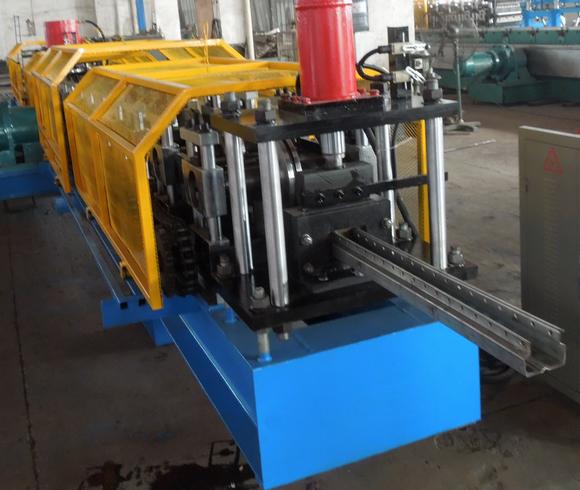
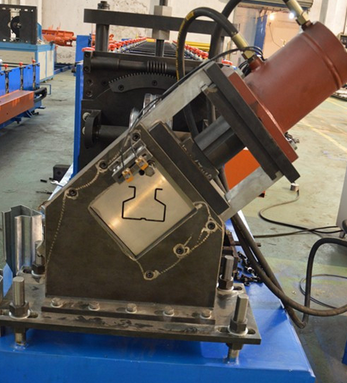
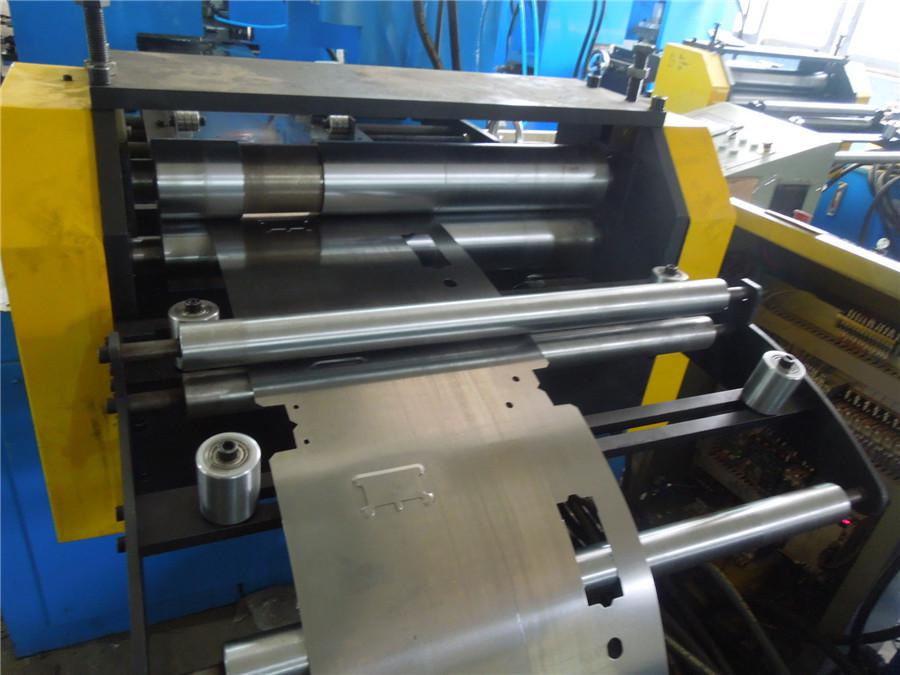

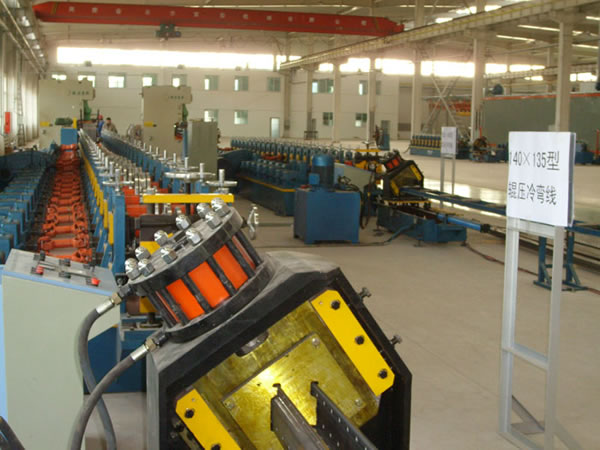

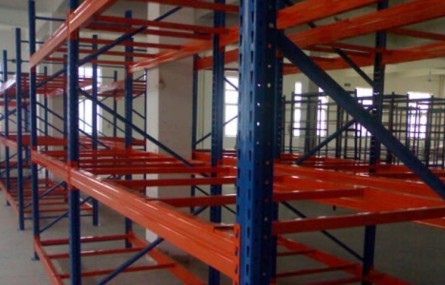
Training and Installation :
1. We offer installation service local in paid, reasonable charge.
2. QT test is welcome and professional.
3. manual and using guide is optional if no visiting and no installation.
Certification and after service:
1. Match the technology standard, ISO producing certification
2. CE certification
3. 12 months warranty since the delivery. Board.
Our advantage:
1. Short delivery period.
2. Effective communication
3. Interface customized.
Storage Upright Roll Forming Machine
Storage Upright Roll Forming Machine,Storage Racking Upright Roll Forming Machine,Lms Storage Upright Roll Forming Machine,Punchig Storage Upright Roll Forming Machine
YingYee Machinery and Technology Service Co.,Ltd , https://www.yingyee.cn